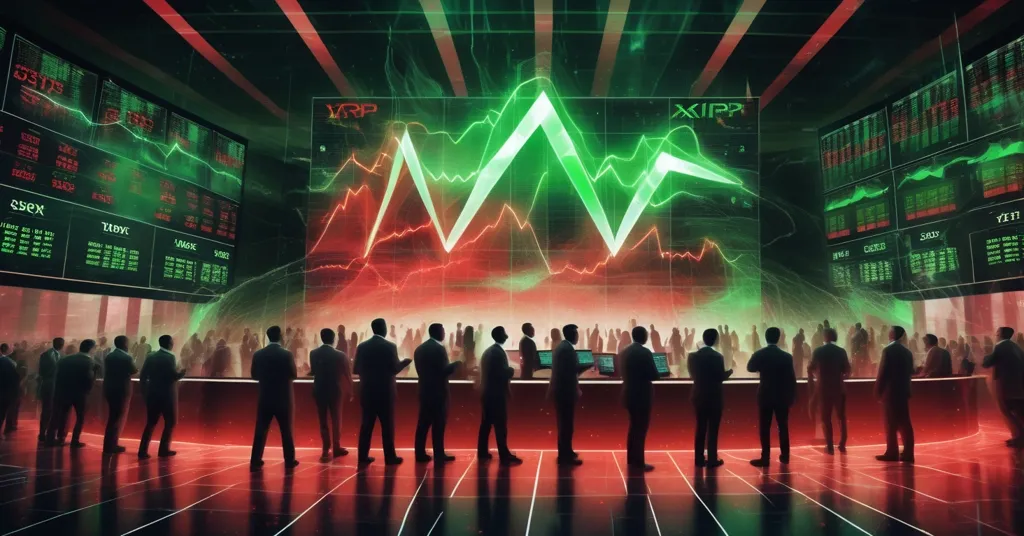XRP ETF Debuts on Nasdaq: Historic Win Amid Market Chaos and Volatility

XRP ETF Launch: A Historic Win Amidst Market Turbulence
XRP just landed a heavyweight punch against regulatory skepticism with the debut of the first-ever US spot ETF on Nasdaq—a monumental step for Ripple’s ecosystem that could redefine its place in the crypto arena. But while the cheers echo for this breakthrough, the market is a chaotic mess of whale maneuvers and retail frenzy, leaving XRP’s price teetering on the edge of volatility.
- Major Milestone: Canary Capital’s XRP ETF, ticker XRPC, launched on Nasdaq with trading starting November 13, 2025.
- Market Shake-Up: Whales stacked XRP pre-approval; retail investors swarmed post-announcement, fueling wild price swings.
- Price Focus: XRP hovers at $2.50, with critical support and resistance levels shaping its next move.
Why the XRP ETF Matters: A Long-Awaited Victory
On November 12, 2025, Nasdaq certified Canary Capital’s XRP ETF for listing, and trading commenced the very next day under the ticker XRPC. This isn’t just another financial product—it’s the first spot XRP ETF on a US exchange, a historic moment for a cryptocurrency that’s been mired in regulatory quicksand for years. Ripple, the company behind XRP, has been locked in a brutal legal battle with the SEC since 2020, when the agency sued them, alleging XRP was an unregistered security rather than a digital commodity. Key milestones, like partial court rulings in Ripple’s favor, have kept hope alive, but the uncertainty has long cast a shadow over XRP’s legitimacy. This ETF approval feels like a middle finger to the doubters—a signal that traditional finance is finally opening its doors to XRP, following the path blazed by Bitcoin and Ethereum ETFs.
For those new to the space, let’s break it down: an ETF, or exchange-traded fund, is like a basket of assets—in this case, XRP—that you can buy and sell on a stock exchange like Nasdaq. Think of it as a way to invest in XRP without the hassle of setting up a crypto wallet or navigating sketchy exchanges. You can trade it through your regular brokerage account, just like shares of Apple or Tesla. This lowers the barrier for everyday investors and brings in big players—think banks, hedge funds, and pension funds—who’ve been hesitant to touch crypto without regulated vehicles. The XRP ETF launch could be a game-changer for Ripple’s adoption, but it also ties the asset closer to the whims of traditional markets, for better or worse.
Market Chaos: Whales vs. Retail Investors
The road to this ETF wasn’t paved with gold—it was a calculated play by the market’s biggest sharks. Data from CryptoQuant reveals that whales, those deep-pocketed investors holding massive amounts of crypto, were quietly accumulating XRP before the ETF news broke, snapping it up while prices were low and compressed. Then, the moment the announcement hit on November 12, retail investors—the smaller, everyday folks buying through apps like Coinbase or Binance—piled in, chasing the hype. It’s like watching a calm lake turn into a tsunami in hours. This clash has sparked intense volatility, with XRP’s price caught in a tug-of-war between calculated whale strategies and retail FOMO (fear of missing out), as highlighted by recent analysis on whale accumulation and retail-driven swings.
Let’s clarify these players: whales are often institutions or individuals with enough crypto to move markets—a single trade from them can send prices soaring or crashing. Retail investors, on the other hand, are the little guys, often driven by emotion or social media buzz rather than long-term strategy. When whales load up quietly, it’s a sign they see value; when retail jumps in late, it often leads to overheating and sharp corrections. Woominkyu, a CryptoQuant analyst, noted that while whale accumulation pre-ETF was a bullish indicator, the retail influx post-launch has created a messy, unpredictable environment. The coming weeks will show whether whales hold steady or dump their stacks for profit, leaving retail bagholders in the dust.
XRP Price Analysis: Decoding the Numbers
Right now, XRP is sitting at around $2.50, stuck in what traders call a consolidation phase. Picture a standoff—buyers and sellers are evenly matched, so the price isn’t making any big moves up or down. It’s hovering in a tight range, but key levels could decide its fate. Support sits at $2.30, meaning if the price dips below that, sellers might take control, pushing it down to $1.90—a deeper zone where buyers have historically stepped in, backed by the 100-week moving average. Think of moving averages as trend lines over time; the 100-week one shows long-term buying interest. On the upside, resistance looms between $2.70 and $3.20–$3.50. If XRP breaks through, it could signal a bullish surge.
For now, the mid-term outlook remains positive, with the 50-week moving average acting as a safety net below current prices. But don’t get too cozy—short-term risks are real. Macroeconomic factors, like inflation concerns or central bank rate hikes, often hit speculative assets like crypto hardest, as investors flee to safer bets like bonds. Add in profit-taking from early buyers, and you’ve got a recipe for sudden drops. I’m not here to play fortune teller with price predictions—those are mostly nonsense peddled by shillers on X. Instead, watch these levels: $2.30 for a potential fall, $2.70 for a breakout. Buckle up; this ride could get rough.
The Bigger Picture: Crypto Meets Traditional Finance
Zooming out, the XRP ETF launch isn’t just about one coin—it’s a bridge between the wild, decentralized world of crypto and the buttoned-up realm of traditional finance (TradFi). Institutional money—those massive cash reserves from hedge funds or corporate treasuries—has been wary of crypto due to its volatility and lack of oversight. ETFs change that by offering a regulated entry point. This could flood the Ripple ecosystem with fresh liquidity, stabilize market sentiment over time, and attract players who’d never touch a crypto exchange. Compared to Bitcoin and Ethereum ETFs, which saw billions in inflows after their launches, XRP’s smaller market cap might mean a more modest impact initially, but the precedent is huge.
Yet, there’s a flip side. Tying XRP to TradFi markets means it’s more exposed to their downturns—think stock market crashes or global recessions. And while Bitcoin’s ETF launches in 2021 sparked price rallies followed by corrections, Ethereum’s in 2024 showed mixed results due to broader market fatigue. XRP could follow a similar boom-bust pattern if retail hype outpaces institutional caution. Plus, could this pave the way for other altcoin ETFs, like Cardano or Solana? If so, it validates a multi-coin ecosystem—something Bitcoin maximalists might grumble about, but I’ll get to that next. For now, this ETF is a step toward mainstreaming crypto, though it’s no guarantee of smooth sailing.
Decentralization Debate: Where Does XRP Fit?
As champions of decentralization, freedom, and privacy, we’ve got to address the elephant in the room: XRP’s model isn’t exactly the poster child for crypto’s ethos. Ripple controls a hefty chunk of XRP’s total supply—roughly 40 billion tokens are held in escrow, released periodically—which raises eyebrows among purists who see Bitcoin’s fully decentralized, no-middleman structure as the gold standard. Critics argue Ripple’s influence over validator nodes (the systems that confirm transactions) makes XRP more of a corporate coin than a true peer-to-peer currency. Bitcoin maximalists, myself included at times, often scoff at this setup as a betrayal of Satoshi’s vision.
Still, let’s not throw the baby out with the bathwater. XRP serves a niche Bitcoin doesn’t touch—fast, dirt-cheap cross-border payments. While Bitcoin is digital gold, a store of value, XRP aims to be digital cash for global transactions, often partnering with banks and payment processors. If this ETF boosts XRP’s credibility in that space, it’s a net positive for the broader fight against centralized financial overlords, even if it’s not pure decentralization. Bitcoin can’t—and shouldn’t—do everything. A diverse ecosystem, where altcoins like Ethereum or XRP fill specific roles, accelerates the financial revolution, even if we’ve got to hold our noses at some compromises.
Warning: Don’t Fall for the Hype or Scams
Before we get too starry-eyed, a harsh reality check: the crypto space is still a breeding ground for scams, and this ETF news is prime bait for con artists. Fake investment schemes posing as official XRPC products, phishing emails promising insider ETF gains, or bogus social media accounts hyping impossible returns—these are already popping up. Don’t be a sucker. Stick to verified sources, double-check any platform before sending funds, and ignore anyone promising XRP will hit $50 by New Year’s. That’s not analysis; it’s a grift. Our mission is adoption through education, not blind hype, so do your homework before jumping in.
What’s Next for XRP? A Grounded Outlook
Looking ahead, the next 6-12 months for XRP hinge on a few key factors. If institutional investors double down on the ETF, inflows could bolster price stability and cement XRP’s role in payments—especially if more banks adopt RippleNet for transactions. Regulatory shifts are a wildcard; while this approval is a win, the SEC or other global bodies could still throw curveballs with new restrictions. Competition from other blockchain solutions, like Stellar or even Ethereum’s layer-2 scaling, might also challenge XRP’s niche. The ETF’s performance in its early months will set the tone—strong trading volume could signal lasting interest, while a fizzle might dampen enthusiasm.
Key Takeaways and Questions for Reflection
- What’s the big deal about the XRP ETF launch on Nasdaq?
It’s the first spot XRP ETF in the US, marking a historic shift toward institutional acceptance and validating XRP as a digital commodity after years of regulatory battles. - Why is XRP’s price so volatile right now?
Pre-ETF whale accumulation clashed with post-announcement retail speculation, creating a perfect storm of buying and selling pressure that’s rocking the market. - How might this ETF drive crypto adoption?
By offering a regulated entry for institutional capital, it could pull in new money and stabilize sentiment, though short-term chaos might deter some newcomers without proper education. - Should Bitcoin maximalists care about XRP’s milestone?
Yes, as it shows altcoins can complement Bitcoin by tackling niches like cross-border payments, even if XRP’s centralized leanings clash with pure decentralization ideals. - What’s the biggest risk to XRP’s momentum?
Institutional profit-taking or macroeconomic downturns could spark sharp declines, especially if retail investors panic at the first dip. - How does the XRP ETF compare to Bitcoin or Ethereum ETFs?
While Bitcoin and Ethereum ETFs saw massive inflows, XRP’s smaller market might limit initial impact, though it still sets a precedent for altcoin inclusion in TradFi. - What regulatory hurdles might XRP still face?
Despite this approval, ongoing or new scrutiny from the SEC or global regulators could reignite uncertainty, impacting investor confidence. - Could other altcoins get ETFs after XRP?
Potentially—success here might open doors for Cardano, Solana, or others, further diversifying the crypto market and challenging Bitcoin’s solo spotlight.
So, where does XRP stand after this bombshell? The ETF is a resounding win, no question, but crypto markets are a ruthless battlefield where today’s victory can be tomorrow’s bloodbath. Whether institutional players hold firm or cash out, and how retail investors navigate the inevitable turbulence, will define XRP’s path forward. Keep your gaze locked on those price levels—$2.30 support, $2.70 resistance—and track the ETF’s trading volume for clues. This is a defining moment in the push for financial freedom and decentralization, even if XRP’s flavor of it isn’t everyone’s cup of tea. The fight’s far from over, and XRP’s got a chance to prove it’s more than just hype. Let’s see if it delivers.



